![]()
![]()
![]()
Use LEFT and RIGHT arrow keys to navigate between flashcards;
Use UP and DOWN arrow keys to flip the card;
H to show hint;
A reads text to speech;
33 Cards in this Set
- Front
- Back
|
Background
|
Background
• Increased susceptibility to infections • Reactivation of latent infections • Increased incidence of certain cancers • Congenital/Primary • Genetic abnormalities in components of immune system • Acquired/Secondary • Results from infection, nutritional deficits, medical treatments |
|
|
LAD I
all |
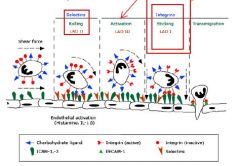
• LADI--most common
• Pathogenesis = absence or defect in beta 2-integrin (CD18) family • Clinical manifestations = recurrent bacterial infections, particularly of the skin and mucosa; leukocytosis; periodontitis**; no pus formation; impaired wound healing • Diagnosis = absence of CD18 and the associated alpha subunits on the leukocyte surface by flow cytometry • Treatment = aggressive management with antibiotics; appropriate vaccinations; careful oral hygiene |
|
|
LADII (rare)
all |
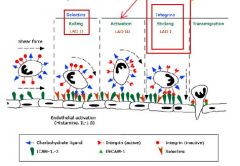
LADII (rare)
• Pathogenesis = absence of fucosylated carbohydrate ligands for selectins • Clinical manifestations = less severe and fewer infections than LADI; severely mentally retarded; short in stature with some facial deformities; delays in motor development • Diagnosis = physical features, mental and growth retardation, recurrent but usually mild infections, marked leukocytosis, and the ***Bombay blood group • Treatment = antibiotics and fucose supplementation |
|
|
LADIII (rare)
all |
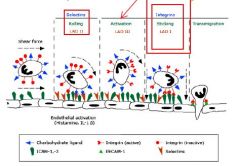
LADIII (rare)
• Pathogenesis = defective activation of all beta–integrins • Clinical manifestations = infections similar to LADI with bleeding complications • Diagnosis = bleeding complications from birth, severe bacterial infections, leukocytosis, demonstration of impaired integrin activation • Treatment = bone marrow or hematopoetic stem cell transplantation |
|
|
Leukocyte Adhesion Deficiency (LAD)
|
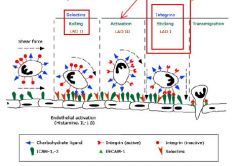
• Leukocytes, particularly neutrophils, cannot migrate from blood vessel into tissues
• Autosomal, recessive |
|
|
Chronic Granulomatous Disease (CGD)
Path |
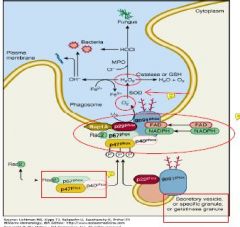
• Impaired phagocytic killing mechanisms of neutrophils and macrophages
• 70% X-linked recessive • Pathogenesis • Lack of a NADPH oxidase subunits (gp91phox or p22phox) • Lack of adapter/ activating proteins (p47phox, p67phox, or p40phox) |
|
|
Chronic Granulomatous Disease (CGD)
Clinical manifestations |
• Deep tissue bacterial and fungal abscesses
• Catalase-positive bacteria (S. aureus and Serratia marcescens) • Burkholderia cepacia • Aspergillus fumigatus |
|
|
Chronic Granulomatous Disease (CGD)
Diagnosis |
• Recurrent and/or unusually severe infections caused by the pathogens commonly associated with CGD
• Neutrophil function tests • Dihydrorhodamine 123 (DHR) test • Nitroblue tetrazolium (NBT) test • Genetic testing |
|
|
Chronic Granulomatous Disease (CGD)
Treatment |
Prophylaxis with trimethoprim/sulfamethoxazole
|
|
|
Chronic Granulomatous Disease (CGD)
Lack of a NADPH oxidase subunits |
• Lack of a NADPH oxidase subunits (gp91phox or p22phox)
|
|
|
Chronic Granulomatous Disease (CGD)
Lack of adapter/ activating proteins |
Lack of adapter/ activating proteins (p47phox, p67phox, or p40phox)
|
|
|
Defects in Lymphocyte Maturation
|
Severe Combined Immunodeficiency Disorder (SCID)
DiGeorge Syndrome |
|
|
Severe Combined Immunodeficiency Disorder (SCID)
• Pathogenesis |
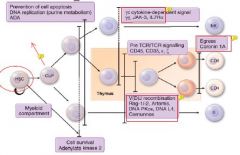
Pathogenesis
• Cytokine signaling deficiency • Purine metabolism deficiency • Defective lymphocyte receptor rearrangements |
|
|
Severe Combined Immunodeficiency Disorder (SCID)
Clinical manifestations |
Clinical manifestations
• Within 3-6 months of life • Recurrent oral candidiasis, failure to thrive, and protracted diarrhea and/or acute interstitial pneumonitis caused by Pneumocystis jiroveci |
|
|
Severe Combined Immunodeficiency Disorder (SCID)
Treatment |
• Hematopoetic stem cell transplant
• Aggressive treatment of infections |
|
|
Severe Combined Immunodeficiency Disorder (SCID)
Diagnosis |
Determination of number of circulating T, B, and NK cells
|
|
|
Severe Combined Immunodeficiency Disorder (SCID)
• Pathogenesis 1. Cytokine signaling deficiency 2. Purine metabolism deficiency 3. Defective lymphocyte receptor rearrangements |
1. gamma receptor --paired with IL7 and IL2 , w/o signal from IL2/7 you dont get clonal expansion, maturation, adaptation of adaptive arm of Immune system
2.cant make nucleic acids, block 3.t-cell/bcell receptors for antigens-->lymphocyte will die w/ no immune response |
|
|
DiGeorge Syndrome
• Pathogenesis |
• Heterozygous chromosomal deletion at 22q11.2 resulting in abnormal development of the embryonic pharyngeal system (thymus)
• 90% heterozygous for microdeletion CATCH22: Cardiac Abnormality (especially tetralogy of Fallot), Abnormal facies, Thymic aplasia, Cleft palate, Hypocalcemia/Hypoparathyroidism. |
|
|
DiGeorge Syndrome
Clinical manifestations |
Clinical manifestations
• Developmental delay, conotruncal cardiac anomalies, hypoplastic thymus, and hypocalcemia • Mild T cell number deficits to complete absence • Humoral deficits secondary to T cell defects • Sinopulmonary infections |
|
|
DiGeorge Syndrome
Diagnosis |
Diagnosis
• Reduced numbers of CD3+ T cells with characteristic triad of features (conotruncal cardiac anomalies, hypoplastic thymus, and hypocalcemia) • Demonstrated deletion in chromosome 22q11.2 |
|
|
DiGeorge Syndrome
Treatment |
Treatment
• Multidisciplinary team including cardiologist, endocrinologist, otolaryngologist, speech/language pathologist, developmental pediatric specialist, and an immunologist |
|
|
Defects in Lymphocyte Activation and Function
• Common Variable Immunodeficiency Disorder (CVID) Path |
Pathogenesis
• Impaired B cell differentiation with defective antibody production • Collection of hypogammaglobulinemias |
|
|
Defects in Lymphocyte Activation and Function
• Common Variable Immunodeficiency Disorder (CVID) Clinical manifestations |
Clinical manifestations
• Recurrent infections, chronic lung disease, autoimmune disorders, gastrointestinal disease, lymphoma • Markedly reduced serum IgG with low levels of IgA and/or IgM |
|
|
Defects in Lymphocyte Activation and Function
• Common Variable Immunodeficiency Disorder (CVID) Diagnosis |
Diagnosis
• Significantly reduced total serum IgG • Low IgA and/or IgM • Poor or absent response to immunization |
|
|
Defects in Lymphocyte Activation and Function
• Common Variable Immunodeficiency Disorder (CVID) Treatment |
Treatment
• IG replacement therapy • Prophylactic antimicrobials |
|
|
Lymphocyte Abnormalities Associated with Other Diseases
• Wiskott-Aldrich Syndrome Pathogenesis |
• X-linked disorder caused by mutations in the gene that encodes the Wiskott-Aldrich syndrome protein (WASp)
• Affects cytoskeletal proteins leading to deficits in immunologic synapse (where ag presenting cells and t-cells come together) • Impaired T cell migration, adhesion, and interaction with other immune cells |
|
|
Lymphocyte Abnormalities Associated with Other Diseases
• Wiskott-Aldrich Syndrome Clinical manifestations |
Clinical manifestations
• Classic: early in childhood with thrombocytopenia; recurrent bacterial, viral and fungal infections; and extensive eczema*** • X-linked thrombocytopenia • X-linked neutropenia |
|
|
Lymphocyte Abnormalities Associated with Other Diseases
• Wiskott-Aldrich Syndrome Diagnosis |
Diagnosis
• Decreased number and function of T cells • Abnormal immunoglobulin isotypes, notably low to normal IgG and IgM and high IgA and IgE • Defective antibody responses to some vaccine antigens • Normal to increased natural killer (NK) cell numbers, but reduced cytotoxicity • Decreased function of regulatory T (Treg) cells • Impaired chemotaxis of phagocytic cells |
|
|
Lymphocyte Abnormalities Associated with Other Diseases
• Wiskott-Aldrich Syndrome Treatment |
Treatment
• Platelet transfusions and prophylactic antimicrobials • IVIG • Hematopoetic stem cell transplant |
|
|
Ataxia Telangiectasia
• Pathogenesis |
Lymphocyte Abnormalities Associated with Other Diseases
• Autosomal recessive disorder associated with defective DNA repair mechanisms • Chromosome 11q22.3 |
|
|
Ataxia Telangiectasia
Clinical manifestations |
Clinical manifestations
• Progressive cerebellar ataxia, abnormal eye movements, oculocutaneous telangiectasias, and immune deficiency affecting both cellular and humoral immunity • Recurrent sinopulmonary infections |
|
|
Ataxia Telangiectasia
Diagnosis |
Diagnosis
• Immunoglobulin deficiency, especially absence or marked reduction of IgA, IgG2, and other IgG subclasses • Inability to produce antibodies to polysaccharide antigens (bacterial capsule-->neisseria, h. inf, strep) • Oligoclonal gammopathy (ab production wild, INCR and random) • T cell lymphopenia |
|
|
Ataxia Telangiectasia
Treatment |
Treatment
• Surveillance and prevention of infections and dysphagia (sinopulmonary cause) |

